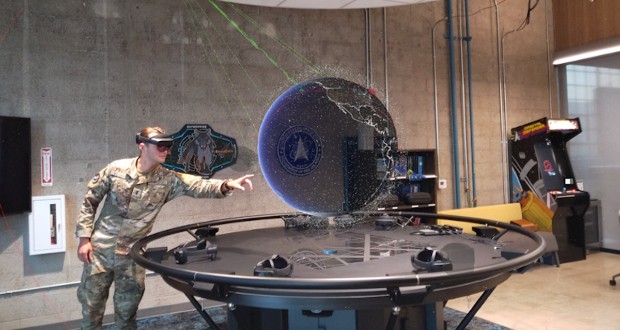The United States Space Force has signed a one-year $19.8 million contract with Microsoft to develop an augmented reality (AR) training environment.
Dubbed the Integrated, Immersive, Intelligent Environment (I3E) contract, the space simulation is constructed on Microsoft’s Azure cloud computing infrastructure and a mesh framework for building shared AR experiences.
The technologies combine to create an interactive model of space with accurately scaled orbital objects that users view via Microsoft HoloLens headsets and can manipulate in real time.
I3E is currently hosting four ‘missions’ on Microsoft’s Azure cloud infrastructure: a physics-based space environment and satellite simulation; space intelligence collection and scheduling; strategic orbital wargaming; and an AR space simulation.
Space Systems Command has begun training personnel on how to utilise the AR tool.
Jordan Savage, a first lieutenant from the Information Mobility Branch, said: “Picking up a headset and being able to visually interact with the planet and satellites and understand space more in depth was mind-blowing.”
The solution is currently available only in the Space Force’s Los Angeles location, but the plan is to roll it out to other locations, so users can access it via a virtual desktop.
The contract period, which was awarded by Space Systems Command on 1 December, has the option to be extended by an additional three years. I3E is a follow-on from the Immersive Digital Facility (IDF) prototype developed with Microsoft Corporation last year.
Colonel Richard Kniseley, senior materiel leader for the Space Systems Command’s Commercial Space Office, said: “I’m blown away watching our young Guardians interact with the cutting-edge technology the I3E offers. Linking numerous sites together through the robust digital ecosystem provides an unrivalled experience to better understand the space domain.”
Shannon Pallone, program executive officer for battle management command, control and communications, said: “Leveraging emerging game-changers like I3E enhances our ability to gain situational awareness and enable decision-makers to act at a higher velocity than our adversaries.”
 AV Magazine AV Magazine
AV Magazine AV Magazine 






Have your say
or a new account to join the discussion.